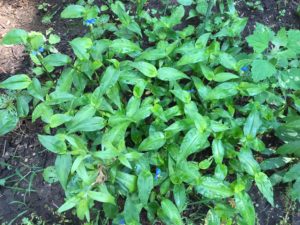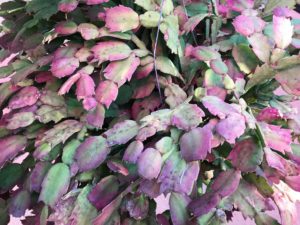Q: I’m having an argument with my wife about a plant in our yard, and we hope you can help arbitrate. I’ve sent a photo of a plant that we found growing near some shrubs. Neither of us remember planting it. My wife thinks it’s pretty ground cover and that we should let it stay. I think it’s a weed and that we should get it out of there before it takes over the whole bed. My wife said, “ask Rosie!”— W & M, Lebanon, Indiana
A: You could both be right, but if I have to choose, I’d say you win the argument! Your photo appears to be Commelina communis, more commonly known as Asiatic dayflower. I’ve included a photo that shows both flowers and leaves. It does have pretty blue flowers, but this non-native plant is generally considered a weed. Because the plant tends to sprawl along the ground, the stems root when they stay in contact with moist soil. This species can form a dense colony that outcompetes other plants. Dig the plant out, removing as much of the root system as possible.
There is a native, closely related species known as slender dayflower, Commelina erecta, that has more narrow-shaped leaves, is more upright, does not form dense colonies, and tends to be found in drier soils.
For more information about each of these species:
Asiatic dayflower – https://www.illinoiswildflowers.info/weeds/plants/asia_dayflower.htm
Slender dayflower – http://www.illinoiswildflowers.info/prairie/plantx/sl_dayflower.htm
Q: What causes Christmas cactus leaves to turn red? Will this cause the plant to die? – D.C., South Bend, Indiana
A: Leaves of holiday cactus often turn red or reddish purple if exposed to excessive light. Too much direct sunlight can actually burn the leaves or may cause them to become limp. This should not cause the plant to die, but burned leaves may fall off. An otherwise healthy plant will be able to grow new leaf segments. Try moving the plants a bit further away from direct light.

